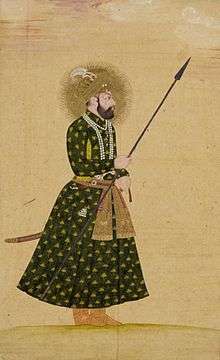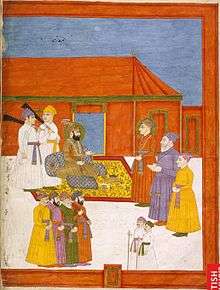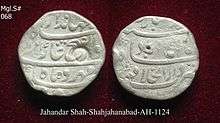Jahandar Shah
| Jahandar Shah | |||||
|---|---|---|---|---|---|
 | |||||
| Reign | 27 February 1712 – 11 February 1713 | ||||
| Coronation | 29 March 1712 at Lahore | ||||
| Predecessor | Bahadur Shah I | ||||
| Successor | Farrukhsiyar | ||||
| Born |
9 May 1661 Deccan, Mughal Empire | ||||
| Died |
12 February 1713 (aged 51) Delhi, Mughal Empire | ||||
| Burial | Humayun's Tomb | ||||
| Spouse |
Saidat-un-Nisa Begum Imtiaz Mahal Begum Anup Bai | ||||
| Issue |
Muhammad Azhar-ud-Din Bahadur A'az-ud-Din Wali Ahd Bahadur Muhammad Aziz-ud-Din Bahadur Alamgir II Izz-ud-Din Bahadur Said-un-Nisa Begum Iffat Ara Begum Rabi Begum | ||||
| |||||
| Dynasty | Timurid | ||||
| Father | Bahadur Shah I | ||||
| Mother | Nizam Bai | ||||
| Religion | Islam | ||||
Mirza Mu'izz-ud-Din Beig Mohammed Khan also called Jahandar Shah (10 May 1661 – 12 February 1713) was a Mughal Emperor who ruled for a brief period in 1712–1713, "a worthless debauch, became emperor after liquidating his three brothers."[1] His title was Shahanshah-i-Ghazi Abu'l Fath Mu'izz-ud-Din Muhammad Jahandar Shah Sahib-i-Quran Padshah-i-Jahan (Khuld Aramgah).
Early life
Prince Jahandar Shah was born on 10 May 1661 in Deccan Subah, to emperor Bahadur Shah I and Nizam Bai, daughter of Mirza Raja Jai Singh. He was appointed Vizier of Balkh in 1671 by his grandfather Aurangzeb.
Upon the death of their father on 27 February 1712, he and his brother Azim-ush-Shan both declared themselves emperor and battled for the succession. Azim-us-Shan was killed on 17 March 1712 and Jahandar Shah was able to rule for a eleven months. Before coming to the throne, Jahandar Shah had sailed around the Indian ocean, and had been a very prosperous trader, and was later appointed Subedar of Sindh. He fathered three sons, including Aziz-ud-Din who reigned as Mughal emperor between 1754 and 1759.
Reign


Jahandar Shah, was very frivolous in lifestyle, his court was enlivened by dancing and entertainment. He chose a favourite wife, Lal Kunwar who was a mere dancing girl before her elevation to the position of Queen Consort. Together they shocked the Mughal Empire and were even opposed by Aurangzeb's surviving daughter Zinat-un-Nissa.
His authority was rejected by the third Nawab of the Carnatic Muhammed Saadatullah Khan I, who killed De Singh of Orchha, mainly because the Nawab believed that he was the righteous commander of the Gingee Fort, and began a smear campaign referring to Jahandar Shah as an usurper to the Mughal throne. To further strengthen his authority Jahandar Shah sent gifts to the Ottoman Sultan Ahmad III.[2]
Rebellion
The Mughal Emperor Bahadur Shah died in 1712 and he was succeeded by Jahandar Shah, the puppet Mughal ruler. Banda Singh Bahadur knew his weaknesses and between his region he captured Punjab region,east of Lahore along with the Mughal territories near trans-Yamuna region.
Death

He was defeated in the battle at Agra on 10 January 1713 by Farrukhsiyar, his nephew and the second son of Azim-ush-Shan, with the support of the Syed Brothers. He fled to Delhi, from where he was captured and handed over to the new Emperor, who confined him along with Lal Kunwar. He lived in confinement for a month, until 11 February 1713, when professional stranglers were sent to murder him. His eldest son Prince Aazuddin died on 12 December 1744.
Coins
Jahandar Shah reintroduced couplets and issued coins in Gold, Silver and copper. Two couplets i.e Abu al-Fateh and Sahab Qiran were used. Copper coins were issued in both weight standard i.e 20 grams and 14 grams.
 Silver Rupee of Abu al-Fateh couplet, Khujista Bunyaad, AH1124 Ry.Ahd
Silver Rupee of Abu al-Fateh couplet, Khujista Bunyaad, AH1124 Ry.Ahd Silver Rupee of Sahab Qiran couplet, Itawa, AH1124 Ry.Ahd
Silver Rupee of Sahab Qiran couplet, Itawa, AH1124 Ry.Ahd Copper paisa of 20.21 grams from Surat mint
Copper paisa of 20.21 grams from Surat mint Copper paisa of 13.85 grams from Surat mint
Copper paisa of 13.85 grams from Surat mint
References
- ↑ Sen, Sailendra (2013). A Textbook of Medieval Indian History. Primus Books. p. 193. ISBN 978-9-38060-734-4.
- ↑ Farooqi, Naimur Rahman (1989-01-01). Mughal-Ottoman relations: a study of political & diplomatic relations between Mughal India and the Ottoman Empire, 1556-1748. Idarah-i Adabiyat-i Delli.
| Wikimedia Commons has media related to Jahandar Shah. |
| Jahandar Shah | ||
| Preceded by Bahadur Shah I |
Mughal Emperor 1712–1713 |
Succeeded by Farrukhsiyar |